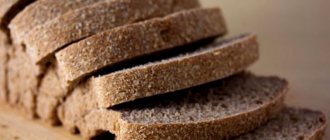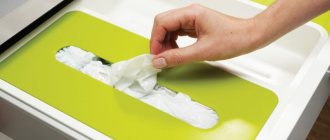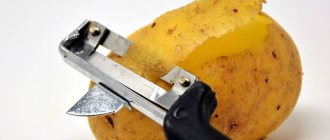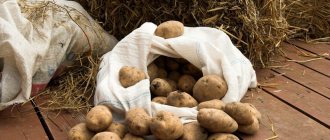Why does it quickly deteriorate and become moldy?
Any product made from flour deteriorates in two ways: either it becomes stale or moldy. In the first case, it becomes tasteless, in the second – harmful and hazardous to health.
When baking, the starch in the flour turns into a paste, absorbing moisture. Over time, he gives it away, the moisture gradually evaporates. Bread practically does not go stale at temperatures below 10 degrees or above 60 degrees. Stale crumb is poorly saturated with gastric juice, therefore, it is less easily digested and absorbed.
As for mold and other harmful microorganisms that cause damage to baked goods, they are always present on the surface of the grain. When grinding, they fall into flour, and then into bread. If it is not baked well, then microbial spores begin to germinate. Therefore, mold is often found inside loaves. The fluffy “carpet” can be of different colors: white, orange, gray. The outside of the crust is baked and thus disinfected quickly, but heat treatment of the middle of large products takes time. Spoilage is accelerated by improper storage conditions.
How to properly store bread at home to prevent it from molding
For the active development of mold, two factors are important: heat and moisture. The storage conditions for bread and bakery products are as follows:
- cleanliness of the premises (no mold, pests);
- dry air (humidity not higher than 75%);
- temperature not lower than +6 degrees.
Excessive moisture is the main enemy of baking. Therefore, a hot, freshly baked loaf should not be kept in a plastic bag or placed in a closed bread bin. This is true for both store-bought and home-baked goods. The fragrant “brick” from the bread machine should be removed from the machine immediately after the end of the process, cooled at room temperature, and only then hidden for safekeeping. This will provide a crispy crust to the product. If the “brick” is left in a metal container after baking, it will become limp due to condensation and will not crisp.
To keep bread fresh for a long time, you should take these factors into account and keep the place where the baked goods are stored clean. Another trick: homemade products will remain soft longer if you add eggs, vegetable or butter, and milk to the dough. The richer the composition of the bun, the slower it becomes stale.
How long can you store bread at home?
The shelf life of bread made from rye flour without packaging is 36 hours, and for baked goods made from wheat flour – 24 hours. If the product is purchased in packaged form, its shelf life (before opening) is written on the label; it can be 72 hours. Simple yeast-free bread without additives remains soft for 3 days. There is no point in saving it any longer: it will become stale or covered with mold.
If the baked goods begin to dry out, it is best to make crackers out of them, which will then be useful for minced cutlets or crushed for breading.
Interesting! For long-term storage of baked goods, preservatives are added to their composition or the surface of the packaging is treated with them, especially resorting to this method in hot weather. There are products on sale with a “lifespan” of several months.
Where to store bread in the kitchen
Baked goods are capable of absorbing various aromas, so they should not be stored at home near products with a strong odor: tea, coffee, spices, and especially near fish and smoked meats. It is best to allocate a separate place for these purposes.
In a small kitchen, the cabinet can be hung on the wall, but not above the stove or radiator. If the size of the table allows, then it is permissible to place a bread bin directly on it. The refrigerator will not work, the products will quickly deteriorate there.
What material to use for storing bread
Freshly baked bread should never be placed in airtight materials; it must first be cooled. To keep it fresh for a long time, you should wrap it in a natural material: linen or cotton towel. When washing, they need to be rinsed well so that no powder remains. A very convenient option is a fabric bag.
A paper bag is also highly breathable, but it is disposable. Just like a towel, you can wrap even hot baked goods in it without getting covered in condensation. It is permissible to store food in a plastic container only if it has ventilation.
You can store bread in cling film or a plastic bag, but not longer than a day and only when it is cold, and you should make holes in them for ventilation using a knife or hole punch to prevent moisture from accumulating inside. The same is true for foil.
Black and white – together or separately?
Products made from different flours spoil differently. Due to the specific composition of proteins and the fact that it is sour, black bread dries out more slowly. It is more resistant to mold and potato sticks. In addition, black bread contains more moisture.
Therefore, it is better to keep products made from wheat and rye flour separately: in different compartments or bags. For storage, the loaves are always placed in one row to ensure good air circulation.
Where and how is the best way to store baked goods?
Proper storage of bread is not just about storing fresh products in a bread bin. Experts suggest considering the following options for approaching the issue:
- In fabric. At home, you can use canvas or a piece of linen. We just wrap the bread in it, then it can be preserved fresh for a week. If after this time a product from the group of bakery products becomes stale, it will not lose its taste and beneficial components.
Tip: The fabric does not need to be changed every time, it only needs to be washed from time to time. Use laundry soap with this ray, but not washing powders with a strong aroma. Even if the smell does not come from the fabric, it will definitely affect the quality of the bread.
- In a polyethylene bag. This method is used for baked goods that do not need to be stored for more than 4-5 days. The main thing is to make sure that condensation does not accumulate on the walls of the bag. For prevention, several holes can be made in the material.
- In a paper bag. The best option for lovers of products with a crispy crust. As a last resort, it is allowed to use thick paper, but without traces of paint. Paper towels will not work with this approach! Contrary to the popular belief of many housewives, paper does not prevent the evaporation of moisture, so such packages cannot be stored in the refrigerator.
- In a special bag. Today, hardware stores offer multilayer bags that can provide bread with the most comfortable conditions. Even after several days of being in such packaging, the freshness and pleasant aroma of baked goods is fully preserved.
- In the freezer. Despite the fact that it is prohibited to keep bread in the refrigerator, it is very possible to use the freezer for this purpose. If you bring the temperature in the chamber to -18ºС, the product will retain its properties for up to six months. This product defrosts at room temperature for a couple of hours. To speed up the process, you can use a microwave or oven. There is only one negative point here - such bread goes stale very quickly, so before processing it is better to cut the loaf into portions and wrap each piece in foil.
- In the bread bin. Oddly enough, this is not the best way to store baked goods. The product will remain in its original form for only a few days; to be sure, popular rumor recommends placing an open salt shaker, half a potato, a piece of sugar or an apple in the container. The bread box must be airtight; it is better to place it in a warm, dry place. It is best to use a wooden product wrapped in linen. It is worth paying attention to the construction made of birch bark; it has natural antiseptic properties.
- In modified form. Making breadcrumbs is also a way to store bread. Moreover, it is not necessary to eat the product in this form; if necessary, it is steamed in a water bath.
Even the listed approaches do not always guarantee the desired result. If there is the slightest suspicion about the quality of the product, it should be thrown away immediately rather than trying to clean off the mold and extend its shelf life.
Fresh, soft bread is an essential attribute of a meal in any home. Bread was especially revered in Rus'; some traditions in this regard have been preserved to this day. Throwing away bread is considered bad manners. Modern baked goods, especially store-bought ones, consist of many components that increase the fluffiness of the crumb and give the crust an exquisite taste, but such bread is stored for a very short time. A warm, fragrant baguette bought in the evening becomes a cracker by the morning. How to properly store bread and is it possible to store bread in the refrigerator?
There is no clear answer to this question, since there are many opinions both for and against this storage method.
Procedure for cleaning bread storage areas
The place where baked goods are stored requires regular cleaning. It should not be tightly closed; it should be ventilated at least once a day so that moisture does not accumulate and a musty smell does not appear. Crumbs should be removed daily by wiping the loaf storage area with a dry towel or paper napkin. If the material of the bread bin allows, it should be cleaned periodically with dishwashing detergent.
What solution is used to wipe bread storage shelves?
Once a week you should do a general cleaning of the bread bin. It is washed with warm water and soap and treated with a solution of acetic acid with a concentration of 1%. This product is used to treat racks and trays for food in catering units and factories in accordance with SanPiN (sanitary and epidemiological rules and regulations). After this, the shelves are wiped or left until completely dry.
Important! You cannot wipe the bread bin with undiluted vinegar; this will damage the material from which it is made. Those who cannot stand the smell of acetic acid can wipe the storage area with vodka (alcohol). This is a more expensive antiseptic, but no less effective.
To get 200 ml of 1% acetic acid solution, you need:
| There is | 70% | 30% | 9% | 6% |
| take ml | 2,86 | 6,67 | 22,22 | 33,33 |
| add water, ml | 197,14 | 193,33 | 177,78 | 166,67 |
Which bread box is best for storing bread?
The choice of bread bin is determined by its ease of use. Each material has its pros and cons.
- Wood is the most natural material. But it absorbs odors and cannot be washed. Changes in temperature and humidity, which are quite common in the kitchen, cause wooden products to crack. A wooden container is beautiful, but not the most durable.
- Plastic. You can only buy a bread box made from non-natural materials if you are confident in their safety. Plastic is easy to care for and is inert. The only drawback is often the smell of plastic and fragility: if handled carelessly, the product will quickly crack.
- Metal. The ideal option for a bread bin is stainless steel. Such containers are not afraid of moisture, washing, corrosion, or odors. It is reliable, durable, but not suitable for any interior.
- glass and ceramic products due to their fragility . These should not be placed in a house where there are children.
An enamel pan with a lid instead of a bread bin is a great option for a budget-conscious housewife.
The volume of the bread bin depends on the size of the family. It is preferable to buy models with two compartments for separate storage of white and black loaves.
Storing in a bread bin: what to do to prevent bread from molding and drying out
To prevent baked goods from spoiling for a long time, several simple conditions must be observed.
- Keep the container clean. You should remove crumbs from it and remove empty bags. Once a month, it is recommended to disinfect the bread bin with a weak solution of vinegar or laundry soap, and then wash it with clean water and dry it well.
- Place white and black bread in separate packaging. The bun will absorb the smell of the black loaf and become tasteless. In addition, different types of product placed in one package spoil faster.
- Use white cotton (linen) fabric, white paper or a woven bag for packaging. If there is only a plastic bag, it must be new and have ventilation holes.
- Do not put freshly baked products into the packaging. A store-bought or homemade loaf should be allowed to cool completely, and only then put it away for storage. If it's a store-bought loaf, it's brought home in a parchment bag. The product from the bread machine is placed on a wire rack, covered with a cloth and left to “simmer” for 2-3 hours.
- If there is a lot of humidity in the kitchen, you should put a cloth bag with salt, apple slices or raw potatoes without peel in the bread bin. These products will absorb excess moisture.
Start cutting the loaf from the middle, not from the edges. Combine the remaining halves and pack tightly. The crumb will not dry out for a long time.
Can bread be stored in the refrigerator?
At low temperatures, baked goods do not go stale so quickly, but there are three reasons why bread should not be stored in the refrigerator:
- Lots of products with strong odors nearby. Wrapping it in a tight bag does not always prevent this.
- High humidity. This is what mold needs, it will grow in temperatures ranging from 5 to 50 degrees as long as there is water.
- If a loaf of bread becomes moldy, and it spoils quickly, its spores will immediately spread to other products.
But you can hide bread in the freezer for a while. At -18 degrees, loaves can last for about a month. But a thawed loaf or “brick” will not be as tasty as a fresh one. It is better to make croutons or hot sandwiches from this bread.
Can I use a refrigerator and freezer?
Can it be stored in the refrigerator or freezer?
The refrigerator helps preserve bread products for a longer time, since temperatures close to 0⁰C prevent the formation of mold.
Storing in the refrigerator causes the product to become hard.
, which disappears after it is removed at room temperature. But after 7 days you should not eat bread.
When storing bread in a freezer at a temperature of -18⁰C, the shelf life under such conditions will be 3 months.
How to restore freshness to bread?
You can revive bread by moistening and heating it. You just need to do this correctly, provided that it is without traces of mold:
- In the microwave. Sprinkle the loaf with water or wrap it in a wet, well-wrung out towel. Place in the microwave for 20 seconds, check for softness, and repeat the procedure if necessary. The slices can simply be placed in the microwave, placing a cup of water next to them. The evaporating moisture will saturate them and make them softer.
- In the oven. The method is similar, only the moistened bread is wrapped in food foil. Place in an oven preheated to 180 degrees for 10-15 minutes. After this, take out the loaf, let it cool a little, and then remove the foil.
- In a slow cooker. Happy owners of this technique can easily make bread soft using the steaming mode. For slices, 2 minutes is enough. Instead of a multicooker, a regular steam bath will do.
- In the package. A simple but time-consuming method. It is necessary to place the slightly stale loaf in a plastic bag, close it tightly, and place it in a warm place. In the hot summer, a lighted window sill is suitable, in winter - a radiator. The heat will cause condensation to form in the bag, which will return the bread's softness.
All the methods described should be used immediately before consuming the product, because they can only revive it for a few hours, then it will begin to go stale again.
Bread is an amazing product; it never gets boring. If you store it correctly, it will remain fresh for a long time and will not lose its beneficial properties.
How to revive stale bread?
Bread begins to go stale after 10-12 hours
if it is stored incorrectly.
In this case, its taste and aroma are lost. In order to refresh stale bread, you should warm it up.
To do this, lightly sprinkle the stale loaf with water and place it in the oven at 150⁰C for 5 minutes.
. Restoring freshness for rye bread will last 6-9 hours, for wheat bread - 4-5 hours.
You can also cut up stale bread, place it in a colander and steam it for a few minutes.
When storing bread products, remember that they need to comply with certain conditions. It is better to buy as much bread as you can possibly consume.
so that he doesn't disappear.
You should not eat expired bread products, they will not bring any benefit and can only harm your health.
When asked how to store bread, most people answer that in a bread bin. If this is where the knowledge ends, then you should not be surprised at the quick spoilage of bakery products and the rapid decline in their taste. Practice shows that by following simple rules, you can preserve the product in its original form for several days.
We should not forget that according to nutritionists, not fresh bread, but bread that has been sitting for a couple of days is considered the most useful. It gets rid of all the substances remaining after the fermentation process, slightly changing its texture. This rule applies only when creating favorable conditions for storing the product.











